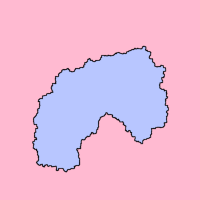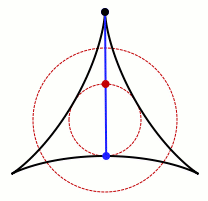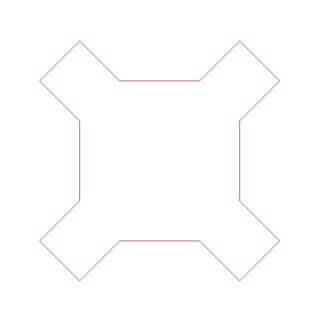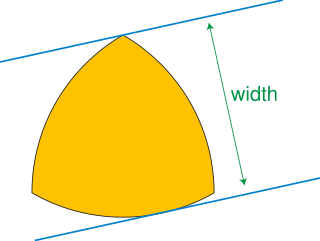In measure theory, a branch of mathematics, the Lebesgue measure, named after French mathematician Henri Lebesgue, is the standard way of assigning a measure to subsets of higher dimensional Euclidean n-spaces. For lower dimensions n = 1, 2, or 3, it coincides with the standard measure of length, area, or volume. In general, it is also called n-dimensional volume, n-volume, hypervolume, or simply volume. It is used throughout real analysis, in particular to define Lebesgue integration. Sets that can be assigned a Lebesgue measure are called Lebesgue-measurable; the measure of the Lebesgue-measurable set A is here denoted by λ(A).

The Sierpiński carpet is a plane fractal first described by Wacław Sierpiński in 1916. The carpet is a generalization of the Cantor set to two dimensions; another such generalization is the Cantor dust.

The Sierpiński triangle, also called the Sierpiński gasket or Sierpiński sieve, is a fractal attractive fixed set with the overall shape of an equilateral triangle, subdivided recursively into smaller equilateral triangles. Originally constructed as a curve, this is one of the basic examples of self-similar sets—that is, it is a mathematically generated pattern that is reproducible at any magnification or reduction. It is named after the Polish mathematician Wacław Sierpiński, but appeared as a decorative pattern many centuries before the work of Sierpiński.

In mathematics, a curve is an object similar to a line, but that does not have to be straight.

In mathematics, the Menger sponge is a fractal curve. It is a three-dimensional generalization of the one-dimensional Cantor set and two-dimensional Sierpinski carpet. It was first described by Karl Menger in 1926, in his studies of the concept of topological dimension.

In topology, the Jordan curve theorem asserts that every Jordan curve divides the plane into an "interior" region bounded by the curve and an "exterior" region containing all of the nearby and far away exterior points. Every continuous path connecting a point of one region to a point of the other intersects with the curve somewhere. While the theorem seems intuitively obvious, it takes some ingenuity to prove it by elementary means. "Although the JCT is one of the best known topological theorems, there are many, even among professional mathematicians, who have never read a proof of it.". More transparent proofs rely on the mathematical machinery of algebraic topology, and these lead to generalizations to higher-dimensional spaces.
In mathematical analysis, a space-filling curve is a curve whose range reaches every point in a higher dimensional region, typically the unit square. Because Giuseppe Peano (1858–1932) was the first to discover one, space-filling curves in the 2-dimensional plane are sometimes called Peano curves, but that phrase also refers to the Peano curve, the specific example of a space-filling curve found by Peano.
This is a list of fractal topics, by Wikipedia page, See also list of dynamical systems and differential equations topics.

In mathematics, a Kakeya set, or Besicovitch set, is a set of points in Euclidean space which contains a unit line segment in every direction. For instance, a disk of radius 1/2 in the Euclidean plane, or a ball of radius 1/2 in three-dimensional space, forms a Kakeya set. Much of the research in this area has studied the problem of how small such sets can be. Besicovitch showed that there are Besicovitch sets of measure zero.

Sierpiński curves are a recursively defined sequence of continuous closed plane fractal curves discovered by Wacław Sierpiński, which in the limit completely fill the unit square: thus their limit curve, also called the Sierpiński curve, is an example of a space-filling curve.
In mathematics, the Smith–Volterra–Cantor set (SVC), fat Cantor set, or ε-Cantor set is an example of a set of points on the real line that is nowhere dense, yet has positive measure. The Smith–Volterra–Cantor set is named after the mathematicians Henry Smith, Vito Volterra and Georg Cantor. In an 1875 paper, Smith discussed a nowhere-dense set of positive measure on the real line, and Volterra introduced a similar example in 1881. The Cantor set as we know it today followed in 1883. The Smith–Volterra–Cantor set is topologically equivalent to the middle-thirds Cantor set.

Édouard Jean-Baptiste Goursat was a French mathematician, now remembered principally as an expositor for his Cours d'analyse mathématique, which appeared in the first decade of the twentieth century. It set a standard for the high-level teaching of mathematical analysis, especially complex analysis. This text was reviewed by William Fogg Osgood for the Bulletin of the American Mathematical Society. This led to its translation into English by Earle Raymond Hedrick published by Ginn and Company. Goursat also published texts on partial differential equations and hypergeometric series.

In mathematics, a Schottky group is a special sort of Kleinian group, first studied by Friedrich Schottky.

William Fogg Osgood was an American mathematician.

The inscribed square problem, also known as the square peg problem or the Toeplitz' conjecture, is an unsolved question in geometry: Does every plane simple closed curve contain all four vertices of some square? This is true if the curve is convex or piecewise smooth and in other special cases. The problem was proposed by Otto Toeplitz in 1911. Some early positive results were obtained by Arnold Emch and Lev Schnirelmann. As of 2020, the general case remains open.

In plane geometry the Blaschke–Lebesgue theorem states that the Reuleaux triangle has the least area of all curves of given constant width. In the form that every curve of a given width has area at least as large as the Reuleaux triangle, it is also known as the Blaschke–Lebesgue inequality. It is named after Wilhelm Blaschke and Henri Lebesgue, who published it separately in the early 20th century.

In topology, the Denjoy–Riesz theorem states that every compact set of totally disconnected points in the Euclidean plane can be covered by a continuous image of the unit interval, without self-intersections.

In mathematical analysis, Netto's theorem states that continuous bijections of smooth manifolds preserve dimension. That is, there does not exist a continuous bijection between two smooth manifolds of different dimension. It is named after Eugen Netto.














